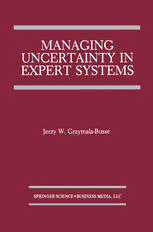
Managing Uncertainty in Expert Systems PDF
Preview Managing Uncertainty in Expert Systems
MANAGING UNCERTAINTY IN EXPERT SYSTEMS THEKLUWERINTERNATIONALSERIES INENGINEERINGAND COMPUTERSCIENCE MANAGING UNCERTAINTY IN EXPERT SYSTEMS by w. Jerzy Grzymala-Busse University ofK ansas SPRINGER SCIENCE+BUSINESS MEDIA, LLC Library of Congress Cataloging-in-Publication Data Grzymala-Busse, Jerzy W. Managing Uncertainty in Expert Systems / by Jerzy W. Grzymala-Busse. p. cm ... (The K1uwer International Series in Engineering and Computer Science ; SECS) Includes bibliographical references and index. ISBN 978-1-4613-6779-6 ISBN 978-1-4615-3982-7 (eBook) DOI 10.1007/978-1-4615-3982-7 1. Expert Systems (Computer Science) 1. Title. II. Series. QA76.76.E95G789 1991 006.3 '3--dc20 Copyright © 1991 by Springer Science+Business Media New York Origina1ly published by K1uwer Academic Publishers in 1991 Softcover reprint of the hardcover 1s t edition 1991 Ali rights reserved. No part ofthis publication may be reproduced, stored in a retrieval system or transmitted in any form orby any means, mechanical, photo-copying, record ing, or otherwise, without the prior written permission of the publisher, Springer-Science+ Business Media, LLC. Printed on acid-free paper. To my mother Estera-Maria and my latefather Witold c o s N T E N T LISTOF FIGURES xiii LIST OF TABLES xv PREFACE xvii 1 INTRODUCTION 1 1.1 ArchitectureofanExpertSystem ~..4 1.2 BuildingExpertSystems 6 1.2.1 Construction Stages 6 1.2.2 ExpertSystemTools 8 1.3 UncertaintyinExpertSystems 9 1.3.1 SourcesofUncertainty 10 1.3.2 Inference under Uncertainty 11 1.4 TaxonomyofExpertSystems 11 1.4.1 ByTaskType l1 1.4.2 By User Interaction and Solution Status 12 2 KNOWLEDGE REPRESENTATION 13 2.1 First..QrderLogic 13 2.1.1 PropositionalCalculus 13 2.1.2 PredicateCaiculus 15 2.2 Production Systems 17 2.2.1 Production Rules 17 2.2.2 Data Base 19 2.2.3 RuleInterpreter 19 2.2.3.1 PatternMatching 20 2.2.3.2 ConflictResolution 20 2.2.4 Forward Chaining 21 2.2.5 Depth-FirstandBreadth-FirstSearch 27 2.2.6 BackwardChaining 27 2.2.7 Metarules 28 2.2.8 ForwardandBackwardReasoning VersusChaining 29 vii viii Contents 2.2.9 AdvantagesandDisadvantages ofProductionSystems 29 2•3 SemanticNets 29 2.3.1 BasicProperties 30 2.3.2 Extended Semantic Nets 30 2.3.3 Concluding Remarks 34 2.4 Frames 34 2.4.1 BasicConcepts 34 2.4.2 lnference 37 2.4.3 AdvantagesandDisadvantages ofFrameSystems 38 Exercises 38 3 KNOWLEDGE ACQUISITION 43 3.1 Manual and Interactive Techniques 44 3.1.1 Interviewing 44 3.1.2 Observation 46 3.1.3 MultipleExperts 47 3.1.4 Psychology-BasedTechniques 47 3.1.5 KnowledgeAcquisitionunderUncertainty .48 3.2 MachineLearning 50 3.3 RuleLearningfromExamples 52 3.3.1 DecisionTables 53 3.3.1.1 A Single Decision Table 54 3.3.1.2 ASetofDecisionTables 58 3.3.2 Indiscernibility Relations and Partitions 60 3.3.2.1 IndiscernibilityRelations 61 3.3.2.2 Partitions 61 3.3.3 AttributeDependencyandRuleInduction 62 3.3.3.1 AttributeDependencyInequality 62 3.3.3.2 EquivalentAttributeSets 63 3.3.3.3 Coverings 63 3.3.4 CheckingAttributeDependency 64 3.3.5 AnAlgorithmforFindingtheSet ofallCoverings 65 3.3.6 AnAlgorithmforFindingaCovering 66 3.3.7 RuleInductionfromaDecisionTable 66 3.3.7.1 EssentialAttributes 67 3.3.7.2 Finding Rules from Coverings 69 3.3.8 AttributeDependencyandDataBases 71 3•4 RuleBaseVerification 71 3.4.1 Consistency 71 3.4.1.1 Redundancy 71 3.4.1.2 Conflict 72 3.4.1.3 Subsumption 72 3.4.1.4 Unnecessary Conditions 72 3.4.1.5 Circularity 73 Contents ix 3.4.2 Completeness 73 3.4.2.1 Unreferenced AttributeValues 73 3.4.2.2 megalAttributeandDecisionValues 73 3.4.2.3 UnreachableConditions 73 3.4.2.4 UnreachableActions 74 3.4.2.5 UnreachableGoals 74 3.4.3 Concluding Remarks 74 Exercises 74 4 ONE-VALUED QUANTITATIVE APPROACHES 77 4•1 ProbabilityTheory 77 4.1.1 DefinitionofaProbability 78 4.1.2 Kolmogorov's Axioms 78 4.1.3 ConditionalProbability 79 4.1.4 IndependentEvents 80 4.1.5 Bayes' Rule 80 4.2 Systems using Bayes' Rule 81 4.2.1 Inference Network 81 4.2.2 BayesianUpdating 81 4.2.3 UncertainEvidence 84 4.2.4 MultipleEvidencesandSingleHypothesis 87 4.2.5 Multiple Evidences and Multiple Hypotheses 88 4•3 BeliefNetworks 89 4.3.1 DetectionofIndependences 90 4.3.2 KnowledgeUpdating 91 4•4 CertaintyFactors 94 4.4.1 BasicConcepts 94 4.4.2 Propagation 95 4.4.2.1 RuleswithCertainSingleConditions 95 4.4.2.2 RuleswithUncertainSingleConditions 95 4.4.2.3 MultipleConditions 95 4.5 ConcludingRemarks 98 Exercises 99 5 TWO-VALUED QUANTITATIVE APPROACHES 103 5.1 Dempster-Shafer11leory 103 5.1.1 FrameofDiscernment 104 5.1.2 Basic Probability Numbers 104 5.1.3 Belief Functions 104 5.1.4 FocalElementsandCore 105 5.1.5 DegreesofDoubtandPlausibility 105 5.1.6 BayesianBeliefFunctions 107 5.1.7 Dempster'sRuleofCombination l09 5.1.8 Support Functions 112 5.1.9 Combining Simple Support Functions 114 5.2 INFERNO 115 x Contents 5.2.1 RepresentationofUncertainty 115 5.2.2 Relations 115 5.2.3 Propagation 116 5.2.4 Constraints 116 5.2.5 Termination of Propagation 120 5.2.6 ConsistencyofInformation 122 5•3 ConcludingRemarks 123 Exercises 123 6 SET-VALUED QUANTITATIVE APPROACHES 127 6.1 Fuzzy Set Theory 127 6.1.1 FuzzySetsandOperations .128 6.1.2 ExtendedVennDiagrams 137 6.1.3 FuzzyRelationsandOperations 138 6.1.4 PossibilityTheory andPossibility Distributions 143 6.1.5 LinguisticVariables,LinguisticModifiers, and the Translation Modifier Rule I44 6.1.6 FuzzyLogic-aPRUFApproach 146 6.1.6.1 PropositionsofFuzzyLogic 146 6.1.6.2 TranslationRules 148 6.1.6.3 Semantic Entailment 153 6.1.6.4 Rules of Inference 156 6.2 Incidence Calculus 158 6.2.1 Incidences 159 6.2.2 ProbabilityCalculusEnhancedby aCorrelation 161 6.2.3 Inference 162 6.3 Rough Set Theory 162 6.3.1 RoughSets 163 6.3.2 RoughDefinabilityofaSet 165 6.3.3 RoughMeasuresofaSet.. 167 6.3.4 Partitions 168 6.3.5 Certain and Possible Rules 170 6.4 ConcludingRemarks 172 Exercises .173 7 QUALITATIVE APPROACHES 181 7.1 ModalLogics .182 7.2 Nonmonotonicity 185 7.2.1 NonmonotonicandAutoepistemicLogics .185 7.2.2 DefaultLogic 187 7.2.3 Circumscription 188 7.2.4 Truth Maintenance System 189 7.2.4.1 Justifications 191 Contents xi 7.2.4.2 NodeTypes 191 7.2.4.3 CircularArgwnents .193 7.2.4.4 Truth Maintenance 195 7.2.4.5 DefaultAsswnptions 197 7.2.5 Reasoned Assumptions 199 7.3 PlausibleReasoning 199 7•4 HeuristicMethods 202 7.4.1 Endorsements 202 7.4.2 CORE 204 7.5 ConcludingRemarks 205 Exercises 205 REFERENCES 209 INDEX 217
